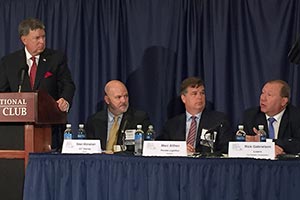Logistics Industry Growing Slowly as Market Alters Capacity, CSCMP Says

WASHINGTON — The anemic freight market, especially for truckload carriers, that started during the last quarter of 2015 continues well into this year, but market forces are already at work to eliminate excess capacity and create a stronger trucking business climate for the sector’s survivors by the middle of 2017, said industry executives participating in a logistics event.
Smaller carriers described as “chasing freight” by offering unsustainable low rates will close eventually, and larger fleets have curtailed orders for new heavy-duty trucks. That combination will help eliminate 80,000 surplus trucks from the U.S. and Canadian market place, according to presentations at the June 21 event here.
The trucking information was part of the Council of Supply Chain Management Professionals’ annual State of Logistics Report. The study said total U.S. business logistics spending grew by 2.6% in 2015 to $1.41 trillion. Logistics as a proportion of U.S. gross domestic product continued its slow decline to 7.85% in 2015 from 7.91% in 2014 and 7.93% the year before.
Sean Monahan, the report’s author and a partner with Chicago-based management consulting firm A.T. Kearney Inc., said five of the major issues for the year in logistics were energy, freight-transportation capacity, inventories, an improvement in efficiency and e-commerce.
“While economic and carrier conditions are expected to continue favoring ‘a shippers’ market’ over the next six months, a realignment of factors — including capacity, inventories, interest rates and economic growth — are projected to result in moderately higher transportation rates in 2017,” the report said in characterizing the business climate.
While most of the changes he described were moderate, the 15% drop in truckload spot market rates, most of which happened during the second half of 2015, were called “dramatic.”
Penske Logistics President Marc Althen said his company monitors the truck market carefully, and he offered the estimate of 80,000 surplus Class 8 trucks to be worked off over the coming 12 months, based on a collection of industry reports.
Reading, Pennsylvania-based Penske sponsored the CSCMP report and ranks No. 29 on the Transport Topics Top 100 list of the largest U.S. and Canadian for-hire carriers. The company owns trucks as part of its dedicated contract carriage business and also provides third-party services, including transportation management.
The soft freight market has eased the driver shortage for Penske, Althen said. While he currently want to hire 150 more drivers for his roster of 4,000 drivers, a year ago the wish list was for 1,000 more drivers, he said.
As a dedicated carrier, he said Penske’s annual turnover rate is 27%, far below the 100% often found in the truckload sector.
The parcel businesses of UPS Inc., FedEx Corp. and the U.S. Postal Service reported 8% revenue growth in 2015 and less-than-truckload carriers — with a lot of variation within the sector — had 7% growth.
Truckload carriers grew by 3%, while private fleets and dedicated contract carriers grew by 1% in 2015, the A.T. Kearney report said.
Freight railroads posted 2% growth in their intermodal revenue but a 12% fall-off in carload revenue, mainly the result of falling demand for coal, once the “black gold” of the rail business.
The report said airfreight is plagued by “overcapacity and falling rates” while Ronald Marotta, a vice president of Yusen Logistics, a division of steamship line NYK Group, said, “Ocean rates are as low as they’ve been for quite a while.”
Full Audio of the Council of Supply Chain Management Professionals’ annual State of Logistics Report

